2017 Honda CR-V Vs Toyota RAV4

Sensibility has become the driving factor behind why crossovers have taken over the market — they have the right mix of practicality, utility, and value that families need.
And there may be no more sensible choices in the midsize crossover market than the Honda CR-V and Toyota RAV4, two vehicles from two Japanese brands known for making no-frills, reliable, sensible machines.
In the battle for sensible supremacy, which of these two is a better purchase? There are plenty of factors to consider, so let’s break it down.
Get the Flash Player to see this player.
The Basics
Power for the Honda comes from a 1.5-liter turbocharged four-cylinder engine making 190 horsepower and 179 pound-feet of torque, while Toyota relies on a 2.5-liter four-cylinder engine making 176 hp and 172 lb-ft of torque to power the RAV4. The turbo setup gives the CR-V a little more punch off the line than the RAV4 and more torque down low, although the RAV4 is adequately powered.
Where the Toyota really starts to fall behind in the powertrain department is fuel economy. Not only does the CR-V make more power, but it also achieves better fuel economy ratings, with the EPA saying the Honda should get 28 mpg in the city and 33 on the highway. On the flip side, the RAV4 is rated at just 22 mpg in the city and 28 on the highway.
There is one clear downside to Honda’s new small turbo: the noise. At full tilt when accelerating onto the highway, this little engine becomes raspy and load, and although it doesn’t feel like it’s straining, it certainly sounds like it is about the give up at any moment.
While the engine and powertrain may not be the first concern of most families, interior space certainly is, and once again, the Honda prevails. Offering a full 40.4 inches of second-row legroom, Honda has shown once again its prowess at maximizing interior space. In the RAV4, second-row passengers are offered 37.2 inches of legroom, which is still a decent size even for a full-size adult. Moving further back, 40 cubic feet of trunk space is offered in the CR-V compared to the 38 cubic feet in the RAV4. Although this difference is negligible in the real world, it’s still impressive to see Honda being able to pack so much usable space into a small crossover.
{"attachment_id":"515656"}
The Drive
When it comes time to hit the road in these two SUVs, it is obvious that they are cut from opposite cloth. While the Honda offers buttery smooth steering and suspension, the Toyota is stiff and feels nimble through corners, acting as more of a knife slicing through the Honda’s smooth buttery feeling.
This really comes down to personal preference, although in such a family-oriented segment, the CR-V’s softer dynamics are likely more desirable.
Safety is an important consideration for the family as well, and in the two fully loaded models we tested, the active systems affect the drive quite a bit. First off, both are fitted with lane keep assist, helping to pull the crossover back into the center of the lane. Both worked well, offering smooth controlled steering inputs that did not feel abrupt or unpredictable in any way.
ALSO SEE: 2017 Honda CR-V vs 2017 Ford Escape
That is not the case with the adaptive cruise control systems, where once again, the Honda proves to be the smarter setup. In the CR-V, the adaptive cruise will allow you to come to a complete stop in traffic without shutting off and will continue on once you press the accelerator. It will also coast when necessary, unlike the RAV4, which loves the grab the brakes abruptly if the car in front comes even slightly too close. And in traffic, the RAV4 will automatically cancel the adaptive cruise if you slow down too much, not allowing you to use the system in stop-and-go traffic.
Finally, talking safety, we must also mention cameras, one of the few areas where the Toyota offers a more comprehensive system. With cameras all around, the RAV4 can give you close-up views beside, behind, and even in front of the vehicle. The system automatically turns on the nose and tail cameras when it senses you are close to something while parking, making it especially convenient. And once you’re parked, the RAV4 gives you a 3D look at exactly where your car is in relation to the spot, so there are no longer any excuses for parking poorly.
Over in the Honda, the CR-V does offer a rear-view camera with three different views, but Honda’s setup is nowhere near as comprehensive.
Inside
Sitting in these two, it’s clear that the Honda feels more upscale, offering wood trim contrasted by piano black on the dash. Toyota’s top-trip RAV4 seems well put together with decent materials, but nothing in the cabin gives a premium feel, disappointing considering we drove the Platinum model.
Compare Specs
| Vehicle | 2017 Honda CR-V | Advantage | 2017 Toyota Rav4 |
|---|---|---|---|
| Engine | 1.5L turbo 4-cylinder | - | 2.5L 4-cylinder |
| Power | 190 hp | CR-V | 176 hp |
| Torque | 179 lb-ft | CR-V | 172 lb-ft |
| Transmission | CVT | - | 6-speed auto |
| US Fuel Economy (MPG) | 28 city, 33 hwy | CR-V | 22 city, 28 highway |
| Trunk Space | 39.2 cu-ft | CR-V | 38.4 cu-ft |
| Total Cargo | 75.8 cu-ft | CR-V | 73.4 cu ft |
| Starting Price | $24,985 | CR-V | $25,370 |
| Starting Price (CAD) | $26,890 | CR-V | $27,445 |
| As-Tested Price | $34,635 | CR-V | $37,110 |
| As-Tested Price w/tax (CAD) | $45,361 | CR-V | $46,982 |
Even the infotainment systems are starkly contrasted, with Honda offering a colorful, intuitive setup next to the Toyota’s slow, boring looking infotainment screen.
Looking at the back seat, Honda has clearly been doing its homework. Two USB ports are found back there, one for each kid to power their device (or for the spoiled only child to power two devices), while there an additional two up front for the parents. In the RAV4, there is a single USB port in the entire vehicle, located up front, while the rear-seat passengers get a 12V outlet.
{"attachment_id":"515658"}
Pricing
And finally, pricing is the final nail in the coffin for the RAV4. Despite a price drop for 2017 that brings the base RAV4 down to $25,370, the Toyota is still slightly more expensive to start than the CR-V, which sells for $24,985.
Comparing our fully loaded models, the story is the same, with the RAV4 Platinum leaving dealerships for $37,110, while the CR-V Touring is less, selling for $34,635.
ALSO SEE: 2017 Honda CR-V vs 2017 Subaru Forester
In the Canadian market, the 2017 RAV4 starts at $27,445 before taxes, while our Platinum model goes for $46,982 with all taxes included. So even north of the border, the CR-V ends up being cheaper, starting at $26,890 before tax and going up to $45,361 for our loaded Touring model including tax.
The Verdict: 2017 Honda CR-V vs Toyota RAV4
This one seems like a no brainer. The Honda CR-V offers more power, better fuel economy and more interior space at a cheaper price. While there isn’t anything particularly offensive or wrong with the RAV4, Honda’s ingenuity makes the CR-V the obvious choice between the two.
Toyota Rav4, Honda CR-V
LOVE IT
- Camera system
- Tight driving dynamics
- Cargo Space
- Turbo power
- Smooth, comfortable drive
LEAVE IT
- Non-premium feel in top trim
- Laggy infotainment
- Engine noise

Stephen covers all of the day-to-day events of the industry as the News Editor at AutoGuide, along with being the AG truck expert. His truck knowledge comes from working long days on the woodlot with pickups and driving straight trucks professionally. When not at his desk, Steve can be found playing his bass or riding his snowmobile or Sea-Doo. Find Stephen on <A title="@Selmer07 on Twitter" href="http://www.twitter.com/selmer07">Twitter</A> and <A title="Stephen on Google+" href="http://plus.google.com/117833131531784822251?rel=author">Google+</A>
More by Stephen Elmer



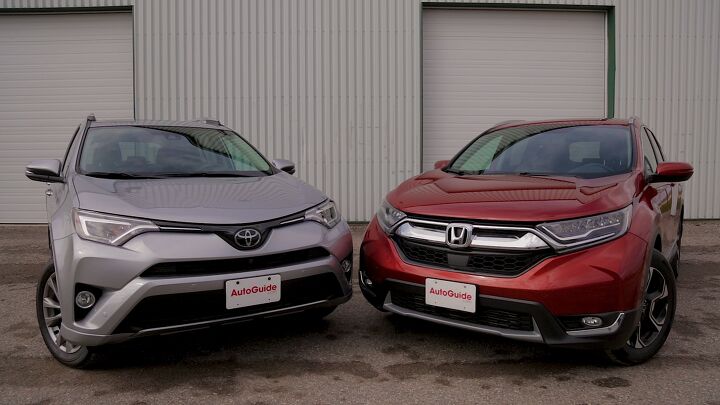
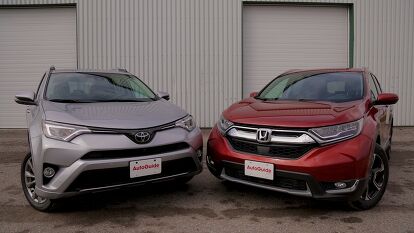






















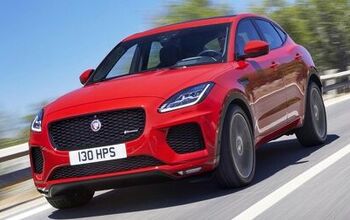




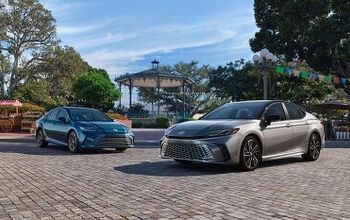


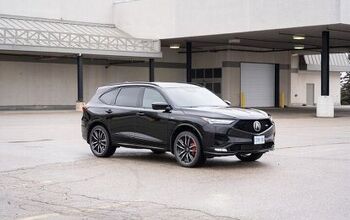

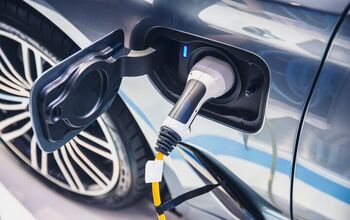
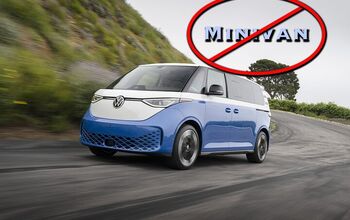

Comments
Join the conversation
This article does not mention that the Rav4 is available as a hybrid. Honda sorely needs that. Also, the Cr-v fuel tank is small. It is about 100 kms off the Hyundai Tuscan in range. That's probably ok in big cities, but a factor outside them.
Are the US prices [for the premium versions] with TAXES IN?